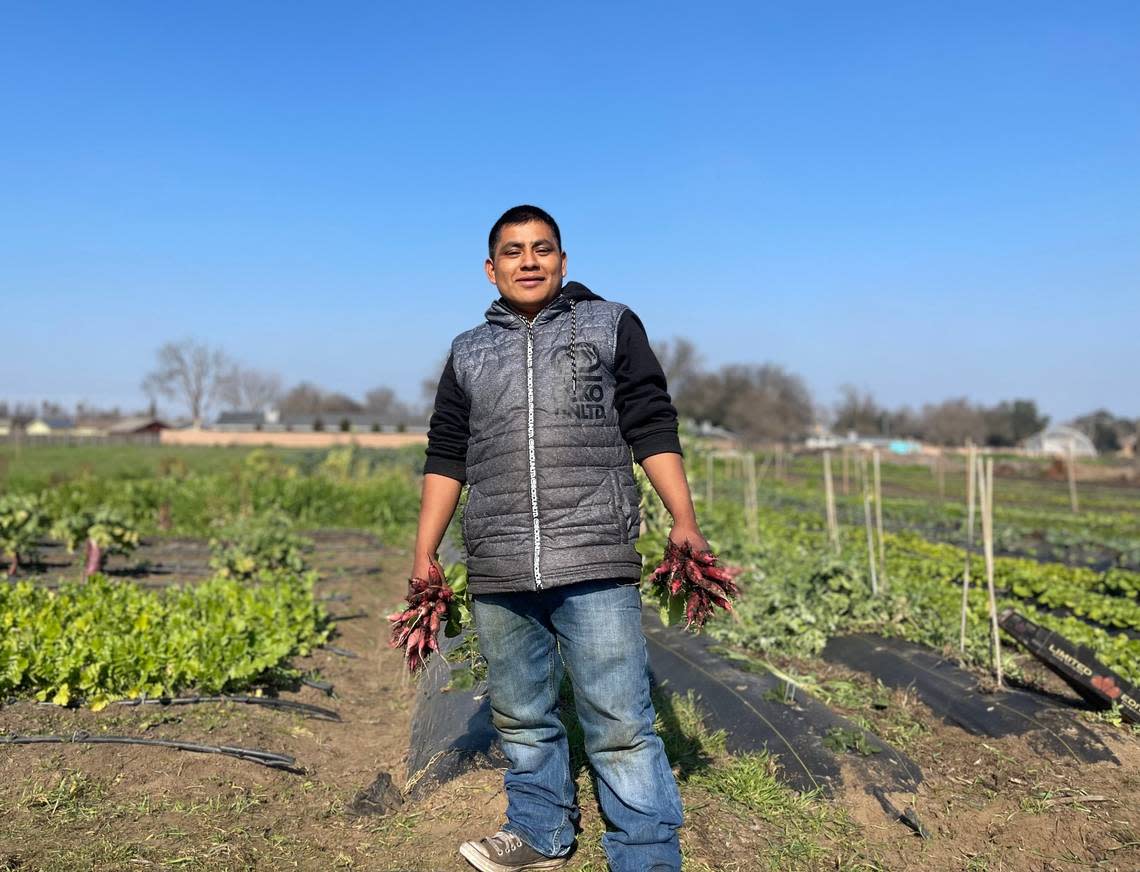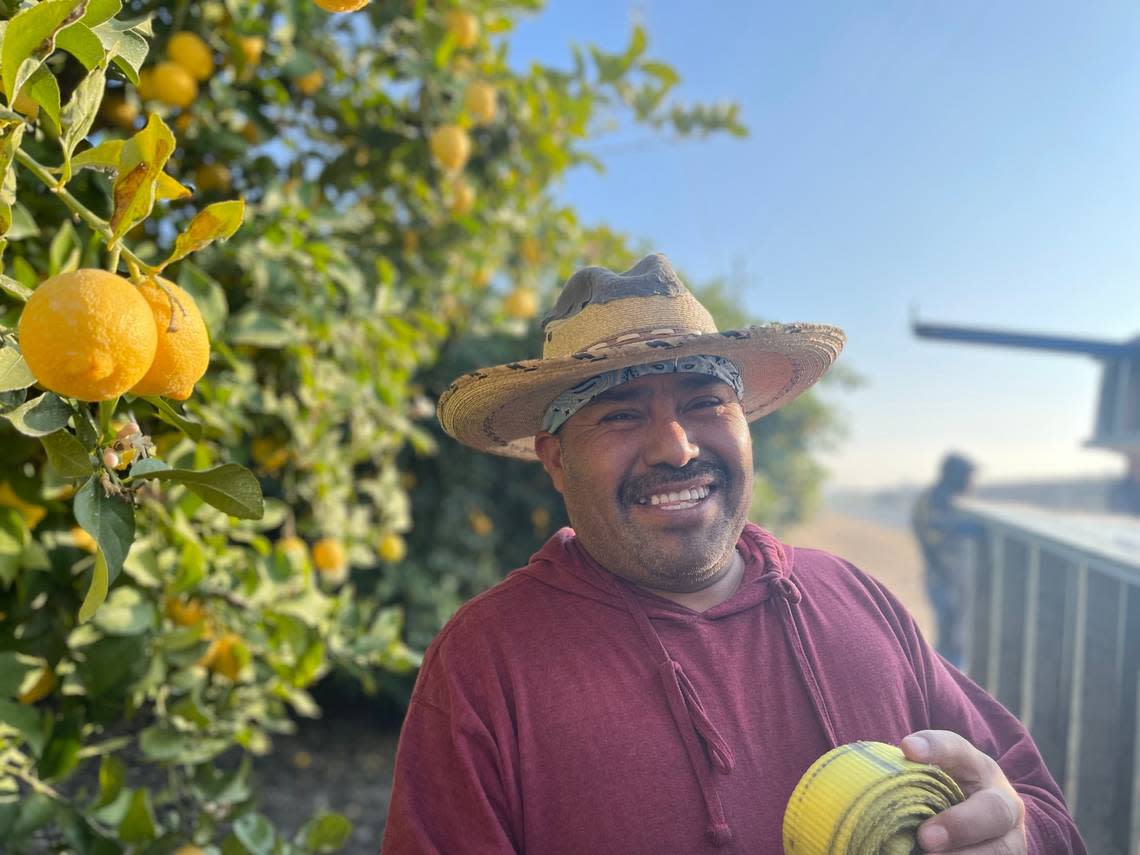‘People with dreams.’ Artist elevates stories of Valley’s Indigenous Mexican communities
Saraí Ramos Gonzalez was born in the Mexican state of Oaxaca and moved with her parents to the United States at age 5. She was undocumented and spent much of her childhood working alongside her parents, who are Mixtec, harvesting fruit in the fields of the Central Valley and Oregon.
At age 17, she earned deportation protection through the Deferred Action for Childhood Arrivals program and, she said, her world opened up.
“Before that, I didn’t allow myself to dream, I told myself I didn’t have papers. I couldn’t go to school,” Ramos Gonzalez said in Spanish. “I didn’t know what to do and fortunately when I got DACA, I had more options and the hope to go to school.”
Ramos Gonzalez is now a 25-year-old graduate of UCLA. She has returned to the Valley, where her digital collection of maps, videos, photos and written narratives are on display as part of Arte Américas’ Boom Oaxaca exhibit. Her work — called ¡Oaxaca, Presente! — utilizes a tablet and TV screens to illustrate the depth, strength and resiliency of the region’s Indigenous communities. It’s her first public showcase.
A collaboration with Elybeth Sofia Alcantar, a 24-year-old Mixteca geographer working on her Ph.D. at the University of Texas at Austin, the collection highlights the Indigenous Mexican community’s ties to Oaxaca, the routes that Mixtecs, Triquis and Zapotecs traveled to reach the Central Valley, their new roles in California and how they prosper while preserving their culture.
“I really wanted to find a way to weave all of this together and show folks who may not typically think of Oaxaqueños as more than farmworkers, to really see Oaxaqueños as business owners, to see Oaxaqueño Indigenous folks, regardless of immigration status, as people with dreams, who are musicians, who are farmers, who are entrepreneurs and who are still very much connected to the Indigenous culture, Indigenous artistry and Indigenous heritage,” said Ramos Gonzalez.
Ramos Gonzalez’s collection, along with the entire Boom Oaxaca exhibit, could help transform popular perceptions of the region’s Indigenous communities, said Sarait Martinez, executive director of the Centro Binacional para el Desarrollo Indígena Oaxaqueño, or the Binational Center for the Development of Indigenous Oaxacans, an organization dedicated to serving Indigenous community members from different Mexican states living in California.
“I don’t want (people) to see us as a community that needs help, because I think what we need is proper access to information,” Martinez said. “We need to stop being seen as people see us, without power.”
Rather, she said, Fresno’s Indigenous Mexican communities should be recognized for their work ethic, agricultural expertise and contributions to the Valley. The community is resilient, she said, but needs better linguistic and culturally appropriate access to public resources.

Approximately 350,000 Indigenous Oaxacans lived in California in 2016 and one-third of the total Mexican agricultural workers in California were of Indigenous origin in 2010, according to the Indigenous Farmworker Study by the University of Southern California and the Mexican research institute El Colegio de la Frontera Norte’s report.
The study found 23 Indigenous Mexican languages were spoken in California’s agricultural industry, with Mixtec, Zapotec and Triqui the most common ones. Many Indigenous Mexican languages are predominantly oral and some community members speak little to no Spanish.
“The concept of needing help comes from this idea that we don’t have things or that we don’t have (resources) in a deficit way, but we’re really not that way,” Martinez said. “I think economic situations make it seem like we need support, but really we just need the respect of our work that needs to happen and the proper access to services that are appropriate to our community.”
Artist embraces her Indigenous Mexican history
Ramos Gonzalez’s artwork is rooted in her own experiences as the daughter of Mixtec immigrants.
She grew up in Farmersville and began migrating with her parents for seasonal work at age 10, picking cherries, oranges, mandarins and lemons in Oregon and all over the Central Valley. The work was hard, she said, but she cherishes the memories made while working with her relatives.
“The beautiful thing about working in the fields is that you’re always with your family,” she said.
La Abeja, a newsletter written for and by California Latinos
Sign up here to receive our weekly newsletter centered around Latino issues in California.
She originally wanted to be a veterinarian, but she changed career paths after taking classes in Chicano studies, food and education at UCLA. She drew on the knowledge she’d gained from her family, her elders and the fields as she worked toward a bachelor’s degree in Chicano studies. Her primary concentration was labor law and policy but she also studied expressive art and “artivism,” or activist art.
“Throughout the entire time, I think I just sat and really reflected on my identity as a Mixteca woman, as an Indigenous woman and a woman from rural Central California, and how that had shaped my experience,” she said. “I felt very fortunate to be so tied to my culture and have so much access to my Indigenous community.”
Today, Ramos Gonzalez considers herself a community archivist focused on storytelling. She’s proud of how her family has intentionally kept their culture and Mixtec language alive in California, despite concerns that they could be stigmatized for doing so.
“As I got older, I really saw how radical and how special that was,” she said. “Not a lot of people have that connection to their Indigenous language, their Indigenous cultures, Indigenous food even.
Fresno exhibit features immigrants from Oaxaca
In ¡Oaxaca, Presente!, Ramos Gonzalez depicts hardworking, powerful Indigenous community members who overcome biases and barriers and helped those around them prosper as well. In a digital format presented on tablets and TV screens, she features interactive stories with audio tracks, photos and videos.
Ramos Gonzalez’s work is divided into three main sections — land stewards, cultural stewards and food sovereignty. She was sure to include her source of inspiration and pride: her parents.
Her mother, Emma Gonzalez, is an Indigenous activist who was part of a committee that brought potable water to her town, San Mateo Nuevo, in Oaxaca. After moving to California, she worked as a field worker until 2018, when she was injured picking eggplants in Fresno. Though disabled now, Gonzalez continues to care for the land and advocate for her Indigenous community in the Central Valley.
Ramos Gonzalez showcased her mother’s story along with other land stewards in the region.
“My mom has just been really an inspiration for the social justice work that I do and why I think I’m so proud to come from a very community-centered background, because that’s how my mom taught me to exist with other people,” Ramos Gonzalez said.

Chapitos de la Sierra is Feliciano Ramos’ band. When he and his brothers are not working in Farmersville as citrus experts in the fields, the group from San Miguel Aguacates plays nostalgic chilenas, a Mexican genre from the Oaxaca-Guerrero coast, and regional Mexican music.
Ramos Gonzalez highlighted them along with other artists as cultural stewards who keep their Mixteca culture alive through their original songs about Indigenous empowerment and pride.
“I think that they’re so cool because they’ve played with really big people like Graciela Beltran and like Los Oros del Norte,” she said.
Boom Oaxaca is on exhibit at Arte Américas, located at 1630 Van Ness Ave. in Fresno until Aug. 14. The exhibit is open to the public and costs $5 per person. The fee is waived on the first Sunday of the month and for Arte Américas members.
The exhibit will be included in Art Hop on Thursday, Aug. 4, offering a free-admission late showing from 5 p.m. to 9 p.m.
